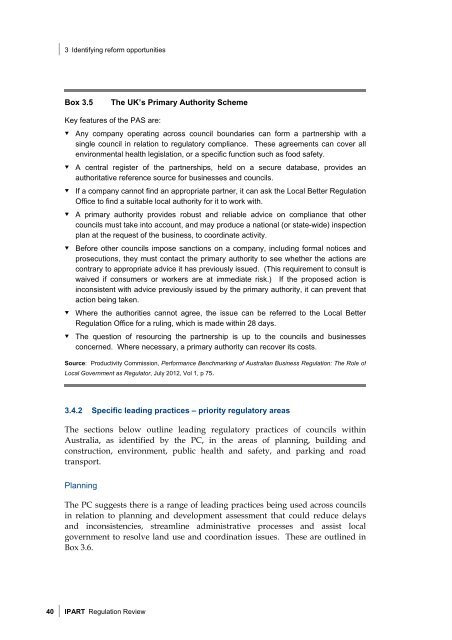Regulation Review - IPART - NSW Government
Regulation Review - IPART - NSW Government
Regulation Review - IPART - NSW Government
Create successful ePaper yourself
Turn your PDF publications into a flip-book with our unique Google optimized e-Paper software.
3 Identifying reform opportunities<br />
Box 3.5<br />
The UK’s Primary Authority Scheme<br />
Key features of the PAS are:<br />
<br />
<br />
<br />
<br />
<br />
<br />
<br />
Any company operating across council boundaries can form a partnership with a<br />
single council in relation to regulatory compliance. These agreements can cover all<br />
environmental health legislation, or a specific function such as food safety.<br />
A central register of the partnerships, held on a secure database, provides an<br />
authoritative reference source for businesses and councils.<br />
If a company cannot find an appropriate partner, it can ask the Local Better <strong>Regulation</strong><br />
Office to find a suitable local authority for it to work with.<br />
A primary authority provides robust and reliable advice on compliance that other<br />
councils must take into account, and may produce a national (or state-wide) inspection<br />
plan at the request of the business, to coordinate activity.<br />
Before other councils impose sanctions on a company, including formal notices and<br />
prosecutions, they must contact the primary authority to see whether the actions are<br />
contrary to appropriate advice it has previously issued. (This requirement to consult is<br />
waived if consumers or workers are at immediate risk.) If the proposed action is<br />
inconsistent with advice previously issued by the primary authority, it can prevent that<br />
action being taken.<br />
Where the authorities cannot agree, the issue can be referred to the Local Better<br />
<strong>Regulation</strong> Office for a ruling, which is made within 28 days.<br />
The question of resourcing the partnership is up to the councils and businesses<br />
concerned. Where necessary, a primary authority can recover its costs.<br />
Source: Productivity Commission, Performance Benchmarking of Australian Business <strong>Regulation</strong>: The Role of<br />
Local <strong>Government</strong> as Regulator, July 2012, Vol 1, p 75.<br />
3.4.2 Specific leading practices – priority regulatory areas<br />
The sections below outline leading regulatory practices of councils within<br />
Australia, as identified by the PC, in the areas of planning, building and<br />
construction, environment, public health and safety, and parking and road<br />
transport.<br />
Planning<br />
The PC suggests there is a range of leading practices being used across councils<br />
in relation to planning and development assessment that could reduce delays<br />
and inconsistencies, streamline administrative processes and assist local<br />
government to resolve land use and coordination issues. These are outlined in<br />
Box 3.6.<br />
40 <strong>IPART</strong> <strong>Regulation</strong> <strong>Review</strong>

















